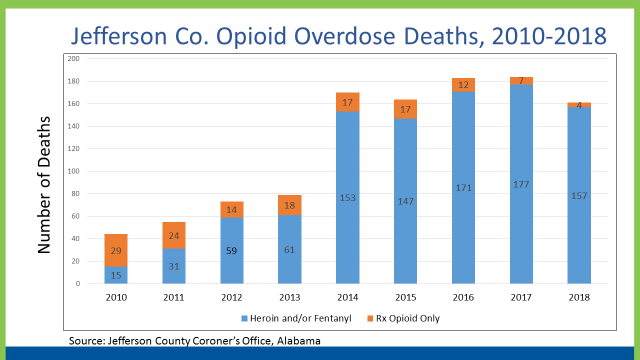UAB Launches Program to Improve Treatment of Opioid Overdose
UAB’s Emergency Department (ED) is starting a new program to better treat patients with opioid use disorder. The initiative, funded with $1.5 million from the U.S. Department of Health and Human Services, focuses on increasing the use of Medication Assisted Treatment Protocol (MAT). This treatment relies on a drug called Suboxone, which reduces withdrawal symptoms for patients recovering from an opioid overdose.
Dr. Erik Hess, vice chair for research in UAB’s Emergency Department, says Suboxone is a very effective treatment for opioid use disorder. But the drug is not used as often as it could be.
“The government has actually made it a requirement for eight hours of training for any provider who wants to provide a subscription for it (Suboxone),” Hess says, “which has set up a pretty substantial barrier for most providers.”
Hess says up until recently, only three ED doctors at UAB had completed this training. The goal now is to certify at least 75% of the department’s physicians to administer Suboxone.
Another focus of the program is to better connect patients with resources once they leave the ED. This involves a partnership with a local referral hub called the Recovery Resource Center at Cooper Green Mercy Health Services.
The Recovery Resource Center will send peer navigators, people who themselves are in long-term recovery, to meet with patients at the emergency department. Navigators will help patients transition out of the ED and find long-term treatment options.
UAB’s new program is funded for three years. During that time, officials expect to enroll more than 500 patients. They hope to see a 30% decrease in the number of deaths due to opioid overdose in Jefferson County. According to the Jefferson County Department of Health, 161 people died from an opioid overdose in 2018.
Q&A: How harm reduction can help mitigate the opioid crisis
Maia Szalavitz discusses harm reduction's effectiveness against drug addiction, how punitive policies can hurt people who need pain medication and more.
The Gulf States Newsroom is hiring a Community Engagement Producer
The Gulf States Newsroom is seeking a curious, creative and collaborative professional to work with our regional team to build up engaged journalism efforts.
Gambling bills face uncertain future in the Alabama legislature
This year looked to be different for lottery and gambling legislation, which has fallen short for years in the Alabama legislature. But this week, with only a handful of meeting days left, competing House and Senate proposals were sent to a conference committee to work out differences.
Alabama’s racial, ethnic health disparities are ‘more severe’ than other states, report says
Data from the Commonwealth Fund show that the quality of care people receive and their health outcomes worsened because of the COVID-19 pandemic.
What’s your favorite thing about Alabama?
That's the question we put to those at our recent News and Brews community pop-ups at Hop City and Saturn in Birmingham.
Q&A: A former New Orleans police chief says it’s time the U.S. changes its marijuana policy
Ronal Serpas is one of 32 law enforcement leaders who signed a letter sent to President Biden in support of moving marijuana to a Schedule III drug.








